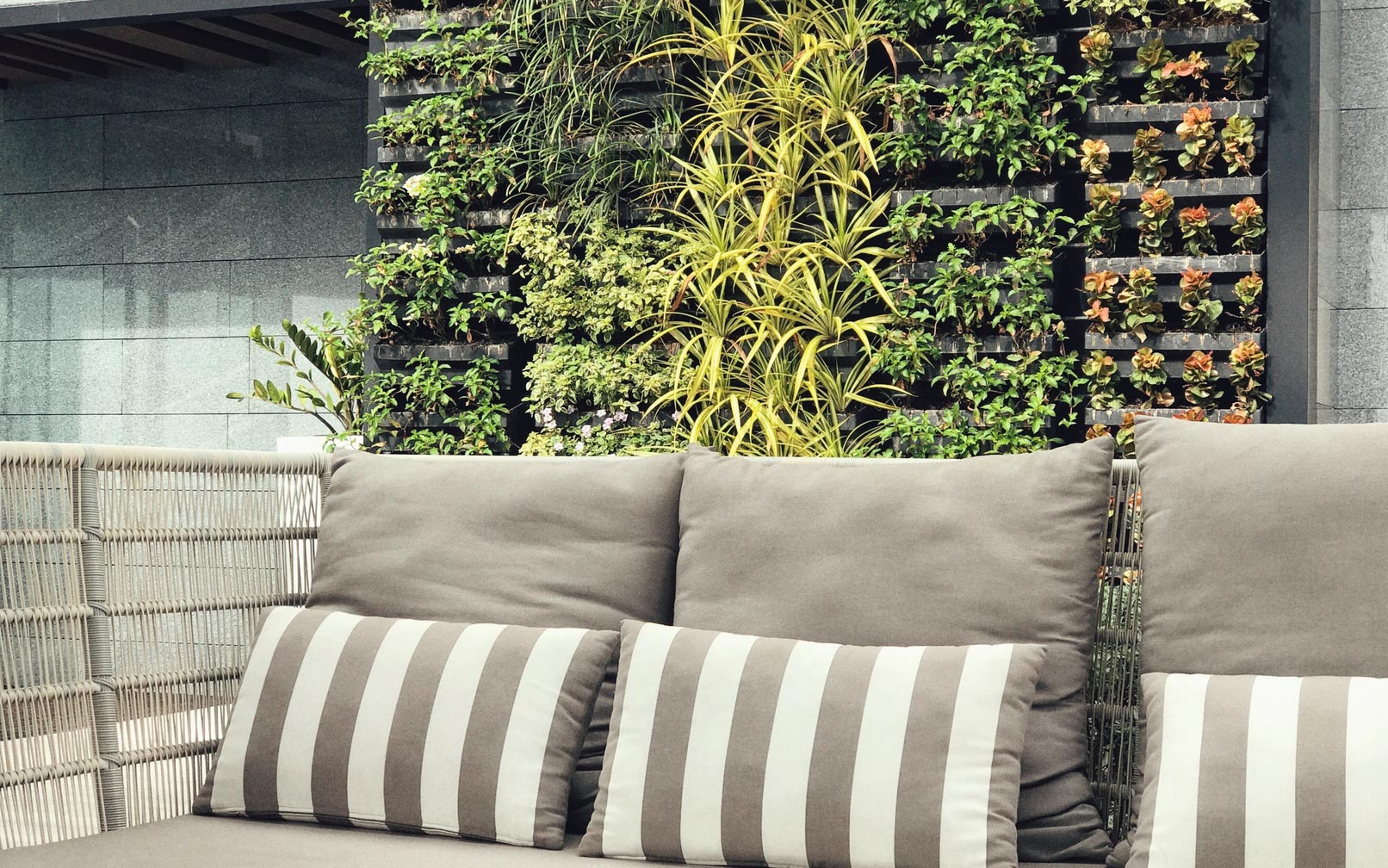To create a successful vertical garden you must pick the right plants, plan according to the weather and ensure planters can support plants after they reach peak maturity. Vertical gardens are found in kitchens, bathrooms, and company workrooms. They are also a popular addition to gardens, patios and backyards. Pretty much anywhere you add a vertical garden, it’ll create a beautiful focal point.
Many years ago, when vertical wall planters first graced the pages of design magazines they were impossibly luxurious to maintain. They required 20-foot ceilings, with access going all the way up, thousands of dollars in plants and a fancy irrigation system. As the popularity of vertical gardens continues to rise, they become increasingly more affordable to implement and maintain.
10 Tips To Add A Thriving Vertical Garden To Your Home Or Business
#1. Decide How Permanent Your Vertical Garden Should Be
Are you renting? Does the location of your vertical garden only get sunshine certain times of the day or year? There are a number of factors that’ll influence how permanent your vertical garden should be.
If certain factors are making you resistant to implement a permanent garden, it’s perfectly achievable to create a portable vertical garden. For instance, an unattached vertical trellis makes an easy to move portable garden. Our affordable, pretty and durable wall planters also make it easy to move your plants as needed.
Shop TerraCast wall planters: https://www.terracastproducts.com/product/tuscany-wall-planters/
#2. Plan According To The Sun & Shade
Plants require a certain amount of sunshine in order to thrive, but vertical gardens can complicate matters. As they grow upwards they can start to block plants beneath from getting any sun. Place plants that prefer more shade at the lower levels of your vertical garden, and keep sun-loving plants near the top.
#3. Pick The Right Plants For Vines
Vines or creeper plants create a beautiful look that can increase privacy and shade. Pick carefully when deciding which plants to grow for this purpose. Consider how much pruning the plant will require and if you will be able to handle this level of maintenance on your own. Research the plant’s mature size so that you don’t end up with a plant that’s too big or too small, which brings us to…
#4. How Tall Will That Plant Grow?
Before planting something in a hanging basket, make sure to check into how tall the plant is slated to grow at full maturity. Plants that are too tall can start to look awkward in hanging planters. Not to mention, they will be more difficult to maintain in regards to pruning, watering and fertilizing.
#5. How Big Will That Plant Grow?
It’s not just height but overall size and weight of plants matter too. When the plant is at peak maturity how heavy will it be? Make sure the structure you select to hang plants from is strong enough to support this weight. Certain plants, such as crops growing larger fruits and vegetables (melons, pumpkins, etc.), may require the addition of a cloth hammock beneath the basket until they are harvested.
#6. Use Hanging Hooks When You Can’t Drill Holes Into Walls
If you can’t drill a hole directly into the side of your fence or wall there’s no need to give up on your vertical garden so soon. Instead, you can get creative in several ways. For instance, by using hanging hooks to display plants.
#7. Careful Where You Hang Things
Hanging baskets and planters can become a liability if people are constantly running into them. Make sure to position hanging baskets or upside baskets in a way that doesn’t create a roadblock.
Also, be mindful that you don’t hang planters so high they are difficult to water and maintain. You might think you can simply pull the hanging basket down, take care of business and then hang it back up. Keep in mind, after planters are filled with foliage, fruits/veggies and wet soil, they are going to be very heavy. If there is no way to avoid hanging your plants out of reach, you can invest in a pulley system that’ll allow you to lower and raise planters as needed.
#8. Vertical Gardens = Thirsty Plants
Plants that are not in the ground and are exposed to more wind and sun (aka plants higher up on a vertical wall) require more water than other plants. Avoid over soaking your plants in water. Instead, regularly check the soil to see if and when plants need more water. Add extra mulch to their bedding to help overcompensate. Quality potting soil is also a great tool to help retain moisture.
Plants that require less water should be placed near the top of the living wall, as gravity will naturally pull water down and cause the top plants to dry out faster. Plants that require wetter conditions will do better near the bottom of a living wall.
#9. Lend A Helping Hand With Cages, Stakes, Etc.
Certain plants naturally grow outwards instead of upwards, which may result in the need to use cages, stakes or trellises to get the plants growing in the direction you want.
#10. Use Silk Plants For Vertical Gardens
You can use silk plants for vertical gardens, completely eliminating the need for maintenance… besides dusting.
Vertical Garden Made Simple: TerraCast Vertical Wall Planters
Our highly affordable vertical wall planters make the perfect addition to any home or business. They are made for both indoor and outdoor use. Our specialized resin-based planters are specially designed to withstand just about anything, not even graffiti can stain these bad boys! Our vertical planters are easy to hang from just about any wall, including outdoor fences and interior walls. You can’t beat our quality or price at just $19.99.
Learn more: https://www.terracastproducts.com/product/tuscany-wall-planters/

